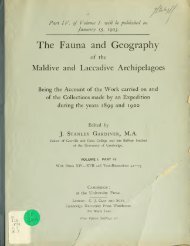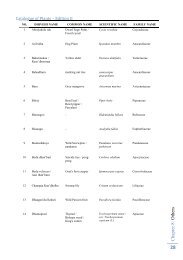Download - WordPress – www.wordpress.com
Download - WordPress – www.wordpress.com
Download - WordPress – www.wordpress.com
You also want an ePaper? Increase the reach of your titles
YUMPU automatically turns print PDFs into web optimized ePapers that Google loves.
egionTHE ENTEROPNEUSTA. 635The vermiform process is usually well-marked and coextensive with the dorso-ventralmuscles. In the instance where these muscles were reduced the vermiform process hadaltogether disappeared.Collar. Willey states that " there is no dorsal septum in the collar, except the foldof basement-membrane associated with the first vestigial root, which is probably to beregarded as a vestige of the dorsal septum. On the other hand the ventral septum hasan unusual forward extension, <strong>com</strong>mencing a short distance behind the region of bifurcationof the nuchal skeleton." In the Maldive forms the dorsal septum is present though onlyat the hind end of the collar (Text-fig. 120, ds.), whilst no ventral septum is to be found.A vestigial root was found in one of the three specimens examined. It was, however,very small and did not reach to the epidermis (Text-fig. 120, ?•.). Both anterior and posteriorneuropores are very deep, so that only about ^ of the collar cord is devoid of a continuouslumen. This portion contained traces of a cavity.In his specimen Willey found that the cornua of the nuchal skeleton extended to theextreme posterior end of the collar. This may be the condition in the Maldive specimens,whilst on the other hand the hindermost quarter of the collar may be without cornua.The collar canals open into the first branchial pouch and I have been unable to findthe truncal canals described by Willey.Trunk. The branchial and genital regions agree closely \vith Willey's account.In the hepatic region there is no internal circular musculature. The longitudinal musclesare gathered into three bands on either side, viz. a dorsal, a ventral, and a lateral one(PI. XLI. fig. 5). Consequently there are in this region two longitudinal areas where nomuscle fibres intervene between the intestinal wall and the epidermis.In the intestinal .there is a longitudinal dorsal groove on either side whichshews slight depressions at intervals (PI. XLI. fig. 7). The circular muscles form a <strong>com</strong>pletering round the body here but the longitudinal muscles are wanting beneath the grooves.The intestine itself is small and laterally <strong>com</strong>pressed, the body cavity being occupied bystrandsof connective tissue.Although there are several small points of difference between the Maldivan forms andWilley's specimen I have thought it best, in view of the considerable variations shewn onthese very points, not to separate these forms from Willey's. It is possible that when morematerial is forth<strong>com</strong>ing the differences may be found to be sufficient to separate them asdistinctvarieties.Spengelia maldivensis, n. sp. (PI. XLI. figs. 6, 8; PL XLII. fig. 20).Locality, etc. Hulule. From beach sand-rock. A single specimen only was obtainedand this lacked the posterior part of the body, which was broken away in the genital region.External features. A small form and the colour after preservation is quite white.The total length of the fragment obtained was 21 mm. Of this the proboscis measured4 mm., the collar 1'8 mm. (with a width of 3 mm.), whilst the length of the branchial regionwas 6 mm. Characteristic is the shortness of the collar, the length of which is not muchmore than half its width. The width of the genital region did not exceed 3 mm.






